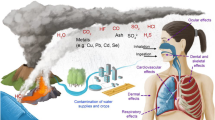Abstract
Istanbul has faced serious air pollution problems since the mid-80s. This is mainly due to particulate air pollution coming from poor quality lignite in areas, which are heavily populated and industrialized. As a consequence of severe air pollution problems, stringent control on the emissions in the city started in the year of 1994. In this work, in order to study the relationship between emissions and meteorological conditions, an assessment of air pollution episodes and air pollution potential in the city is presented for the terms at the changed emission schedule as the influence of an emission reduction strategy. The influence of meteorological conditions on the TSP (total suspended particulates) levels is considered for two consecutive winter periods. On this occasion, the city has faced different TSP levels and episode characteristics depending on stringent emission reductions covering the banned, poor-quality lignite and fuel switching. For this purpose, climatological conditions and air quality analyses were performed.
Similar content being viewed by others
References
APCR (1998): Air pollution country report. Republic of Turkey, Ministry of Health, Refik Saydam Centre of Hygiene
Ayalp A (1976): Istanbul’da Atmosfer Kirlenmesi. PhD Thesis (in Turkish) Istanbul University
Batuk DN, Gürsoy E, Ertut H, Erdun H, Incecik S (1997): Analysis of SO2 and TSP under meso-scale weather conditions in Istanbul, Turkey. Environmental Research Forum 7–8, 73–87
WMO (1997): Habitat II The Outcome. World Climate News, 11
Edgerton S, Arriaga JL, Archuleta J, Cjow JC, Coulter RL, Neff W, Petty R (1999) Particulate air pollution in Mexico City: A collaborative research project. J Air &Waste Management Assoc 49,1221–1229
ErrürkF (1986): Investigation of strategies for the control of air pollution in the Golden-Horn region, Istanbul using a simple dispersion model. Environmental Pollution B 11, 161–168
IncecikS (1986): A Mesometeorological investigation of air pollution problem in Golden-Horn Istanbul. Boundary Layer Meteorology 36, 93–100
Incecik S (1996): Investigation of atmospheric conditions in Istanbul leading to air pollution Episodes. Atmospheric Environment 30, 2739–2750
Karaca M, Tayanç M, Toros H (1995): The effects of urbanization on climate of Istanbul and Ankara. Atmospheric Environment 29,3411–3421
Kallos G, Kassomenos P, Pielke R (1993): Synoptic and mesoscale circulations associated with air pollution episodes in Athens, Greece. Boundary Layer Meteorology 63, 163–184
Kassomenos P, Kotroni V, Kallos G (1995): Analysis of climatological and air quality observations from greater Athens area. Atmospheric Environment 29, 3671–3688
Mage D, Ozolins G, Peterson P, Webster A, Orthofer R, Veweerd V, Gwynne M (1996): Urban air pollution in megacities of the world. Atmospheric Environment 30, 681–686
Ministry of Environment (1992): Environment for the years 2000 (in Turkish). Ankara.
New Directions (1997): Toward better human exposure estimates for setting of air quality Standards. Atmospheric Environment 31, 4253–4254
Pissimanis DK, Karras GS, Notaridou VA (1991): On the meteorological conditions during some strong smoke episodes in Athens. Atmospheric Environment 25B, 193–202
Population and Environment (1996): HABITAT II June. Istanbul
Saglamer G (1997): Rapid urbanization and its consequences on air pollution in Istanbul. Environmental Research Forum 7-8, 2–11
Tayanç M (2000): An assessment of spatial and temporal variation of sulfur dioxide levels over Istanbul. Environmental Pollution 107, 61–69
Tebbens BD (1970): Investigating air quality in Istanbul. Bulletin of Istanbul Technical University 22, 55–63
Tokgöz N, Demir G, Yazgaç U, Bayat C (1999): Istanbul ili hava kirliliginin yerlesim alanlari ile tüketilen yakitlar bazinda emisyon veri analizi ve degerlendirilmesi (in Turkish). Air Pollution and Control National Symposium. Izmir, 271–278
Topcu S, Dilmaç S, Asian Z (1995): Study of hourly solar radiation data in Istanbul. Renewable Energy 6, 171–174
Topcu S, Unal YS, Incecik S (1999): Istanbul’da asili partiküler maddenin yersel degisimine etki eden faktörler (in Turkish). Air Pollution and Control National Symposium, Izmir, 286–295
Van Der Zee SC, Hoek G, Harssema G, Brunekreef B (1998): Characterization of particulate air pollution in urban and non-urban areas in the Netherlands. Atmospheric Environment 21, 3717–3729
Unal YS, Incecik S, Borhan Y, Mentes S (2000): Factors influencing SO2 levels in Istanbul. J Air and Waste Management Assoc 50, 75–84
Author information
Authors and Affiliations
Corresponding author
Rights and permissions
About this article
Cite this article
Sema, T., Selahattin, I. & Yurdanur Sezginer, U. The influence of meteorological conditions and stringent emission control on high TSP episodes in istanbul. Environ Sci & Pollut Res 10, 24–32 (2003). https://doi.org/10.1065/espr2001.10.096
Received:
Accepted:
Issue Date:
DOI: https://doi.org/10.1065/espr2001.10.096




